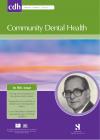Community Dental Health

- Cover Date:
- June 2011
- Print ISSN:
- 0265 539X
- Vol:
- 28
- Issue:
- 2
Is there a correlation between dental caries and body mass index-for-age among adolescents in Iran?
Aim Obesity in adolescents is a public health problem and is steadily increasing in many countries. The aim of this study was to investigate the association between age-and gender-specific body mass index (BMI-for-age) and dental caries among adolescents aged 12 -15 years in Rafsanjan, Iran. Materials and Methods Following ethical approval, 747 students aged 12-15 years were randomly selected from 12 state and private secondary schools in Rafsanjan, Iran. The DMFT index (following World Health Organization criteria) was used to assess the subjects’ previous and existing dental caries experience. The BMI (Body Mass Index) percentile was calculated using BMIfor-age criteria as underweight (<5th percent), normal-weight (5th-85th percent), at risk of being overweight (>85th and <95th percent) and overweight (≥95th percent). Results Of 353 males and 394 females examined, 7.5% were underweight, 72.8% were normal-weight, 13.8% were at risk of being overweight, and 5.9% were overweight. The mean DMFT was 2.83. There was no significant difference between DMFT scores amongst the BMI-for-age groups (underweight = 2.91, normal-weight = 2.92, at risk of overweight = 2.54, overweight = 2.34, p>0.05). However, males were more likely to have caries than females (11% of males were caries-free, in comparison to 20.6% of females; p<0.05). Conclusion Almost one in five adolescents (19.7%) examined were deemed to be at risk of being overweight, or were classified as overweight. There was no association between DMFT scores and BMI-for-age scores.
Keywords: Adolescent, BMI-for-age, body mass index (BMI), dental caries, Iran, obesity.
- Article Price
- £15.00
- Institution Article Price
- £
- Page Start
- 174
- Page End
- 177
- Authors
- M. Sadeghi, C.D. Lynch, A. Arsalan
Articles from this issue
- Title
- Pg. Start
- Pg. End
- Socioeconomic inequality in self-reported oral health status: The experience of Thailand after implementation of the Universal Coverage policy
- 136
- 142
- Relationship between dental anxiety, general anxiety level and depression in patients attending a university hospital dental clinic in Turkey.
- 149
- 153
- Relationship between bone fragility of the mandibular inferior cortex and tooth loss related to periodontal disease in older people
- 165
- 169
- The Relationship between Self-Reported Oral Health, Self-Regulation, Proactive Coping, Procrastination and Proactive Attitude
- 170
- 173
- Is there a correlation between dental caries and body mass index-for-age among adolescents in Iran?
- 174
- 177
- Nigerian dentists’ knowledge of the current guidelines for preventing infective endocarditis
- 178
- 181
